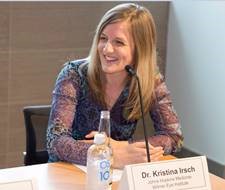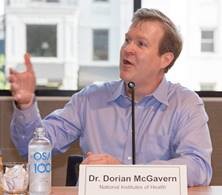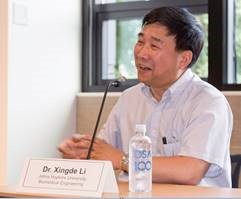Medical Imaging Speakeasy: Revolution through Optical Technologies
Michael Forkner, OSA & SPS
Medical imaging technologies is a powerful growing market with ample room for growth and development. Recently, OSA hosted a panel on The Medical Imaging Revolution through the Speakeasy Science Program. The program, funded by a grant from the American Institute of Physics (AIP) and in partnership with the American Physical Society (APS), strives to increase communication between scientists and the public. The panel focused on new techniques and advances in biomedical imaging and how it will affect the medical industry for years to come.
 |
Dr. Kristina Irsch, from Johns Hopkins Medicine and the Wilmer Eye Institute, talked about her research on a device used for early detection of amblyopia in children through retinal scans. The device, still in testing, is a quick and painless way to mass test children for amblyopia at an early age. Irsch sees the device being used in elementary schools, creating a revolution in the early detection of diseases and syndromes in school-aged children.
 |
Dr. Dorian McGavern, from the National Institutes of Health (NIH), presented his research on using two photon imaging for live in vivo monitoring of the brain. His work, which primarily focuses on concussions, studies how the immune system repairs itself after an injury. When asked why he was so passionate about his research, he responded that not only was his research helping people, but also provides an intense satisfaction when he is able to see things that no one else has seen. To McGavern, the immune system is a puzzle, and he wants to be the first one to unlock its secrets.
 |
Dr. Xingde Li, from Johns Hopkins University’s Department of Biomedical Engineering, was particularly enthusiastic about his research on Optical Coherence Tomography. His focus is the on design and development of cutting-edge bio-photonics technology. Li’s goal is early detection and treatment of disease. It is often the case that the development of a new technology or technique will be the death of an old one. In Dr. Li’s opinion, biomedical imaging is such a wide field that no new optical device can perform all the functions necessary. Each piece of equipment is a new way to look at the problem, and each provides a necessary piece to solve it. Not only are there new technologies currently being developed, but it will not replace old equipment – allowing for continued growth of the imaging market.
Instead of focusing on the technical aspect of their research, each speaker detailed why their research was important and why the public should want to learn more. The Speakeasy Science Program is working to bring scientists and science writers together to educate the public on why scientific research is an essential part of progress as a society.
